Respiratory System
The respiratory system is meant for providing oxygen to our body machine and removes carbon-dioxide from it. Let us have a look at the structures involved in the process of respiration. Structurally respiratory system is divided into two parts
- Upper respiratory tract includes nose with two openings called nostrils leading to nasal cavity, pharynx and associated structures. ( Fig. 1)
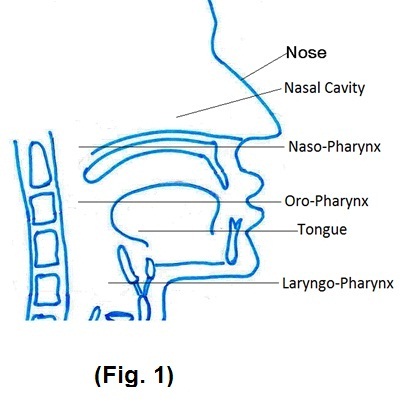
2. Lower respiratory tract includes larynx, trachea, bronchi and lungs. (Fig. 2)
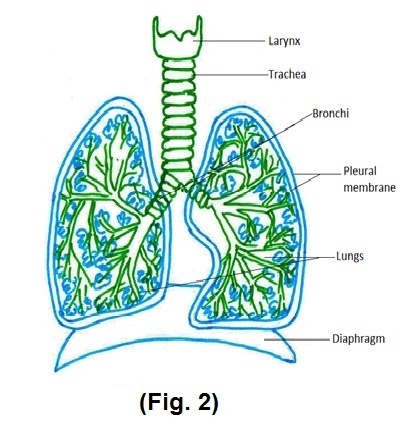
Air first passes through the nostrils to nasal cavity which has two parts, External and internal. External part contains nasal hairs which help in trapping foreign particles present into the inhaled air. Structurally, it has bones, cartilages and septum. Septum divides it into left and right nostril. Deformity of septum causes deviated nasal septum, a common condition observed in practice. Air then enters into internal nasal cavity, which is lined by mucus membrane which secretes mucus. It helps in washing out foreign particles. Cilia, present on mucus membrane, continuously vibrate in direction of oro-pharynx. This helps movement of mucus towards oro-pharynx, from where it is either thrown out through mouth or swallowed. Other functions of nose include warming and humidification of air.
Sinuses – These are 4 in numbers – frontal, ethmoid, maxillary and sphenoid. Sinuses are cavities in bony structures, which open into nasal cavity. Besides producing mucus, sinuses also serve as resonant chamber for sound while talking and singing.
Then air enters into the throat, which includes three structures, pharynx, tonsils and larynx.
The portion of pharynx which opens into larynx is called laryngo-pharynx. Larynx is a cartilaginous structure, out of which, arytenoid cartilages form vocal cord. Movements of vocal cord are responsible for the speech. Posteriorly, pharynx opens into the esophagus. Epiglottis is a leaf like piece of elastic cartilage, one side of which is attached to thyroid cartilage. The other side is free to move. While swallowing movements of pharynx and larynx make epiglottis to close laryngeal opening Therefore food moves into esophagus. (Fig. 3)
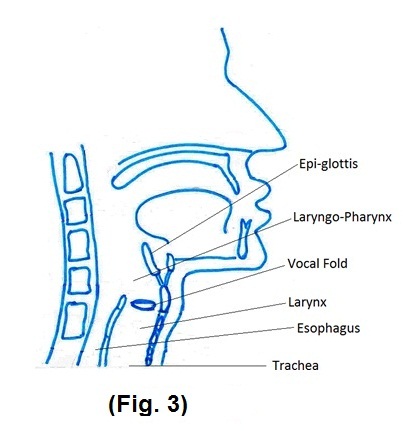
Tonsils are part of lymphoid tissue in pharynx. It plays an important role in providing immune response to organisms entering into pharynx. Recurrent infections of tonsils are common in children.
Now, air enters into trachea. Trachea is divided further into right and left primary bronchi. (Ref Fig. 2)
Bronchi are further divided into smaller and smaller units through which air passes. As the bronchi become smaller and smaller, cartilages of bronchi are replaced by smooth muscles. In bronchial asthma spasm of smooth muscles take place. Smaller bronchi are termed as bronchioles which end into alveolar ducts.
Alveoli -Alveolar ducts open into number of alveoli surrounded by alveolar sac. Alveolar sac consists of two or more alveoli which has common openings. (Fig. 4)
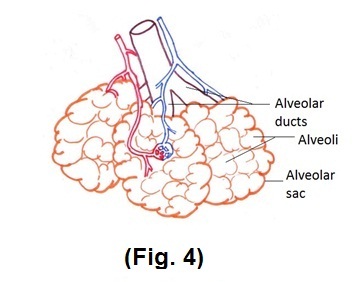
Process of respiration —
It includes inspiration and expiration.
Inspiration means breathing in. It starts when concentration of carbon-dioxide increases or concentration of oxygen decreases in arterial blood. Increase in concentration of carbon dioxide or increase in concentration of hydrogen ions in the blood acts directly on the respiratory center. This causes stimulation of inspiratory area, a part of respiratory center located in medulla. Decrease in concentration of oxygen in blood does not have direct effect on respiratory center. Instead it acts on peripheral receptors located in carotid and aortic bodies. These in turn transmit neural signals to the respiratory center and activate inspiratory area. If outside air has to enter into the lungs, the pressure inside lungs must become lower than the atmospheric pressure. This is achieved by stimulation of inspiratory area. Inspiratory area sends signals for about 2 seconds to external intercostal muscles via intercostal nerves and to the diaphragm via phrenic nerve. These impulses cause contraction of diaphragm and external intercostal muscles which leads to expansion of chest wall. This increases lung volume which in turn decreases pressure inside the lungs. At the end of 2 seconds, inspiratory area becomes inactive. After inspiration, expiration begins because of passive elastic recoil of the lungs and chest wall muscles. So, in normal breathing expiration is a passive process.
Lungs are like balloons which expand during inhalation. During exhalation, though volume decreases it remains in semi-expanded condition because of surfactant. Surfactant is a complex mixture of phospholipids and lipoproteins. Surfactant is present in the alveolar fluid secreted by alveoli. Surfactant lowers the surface tension of alveolar fluid which in turn helps to prevent tendency of alveoli to collapse.
Ventilation — We will now discuss the exchange of oxygen and carbon-dioxide which occurs into the alveoli. This process is called as ventilation. This exchange occurs between air in the alveoli and blood in pulmonary capillaries, across alveolar wall and capillary wall which together form respiratory membrane. (Fig. 5)
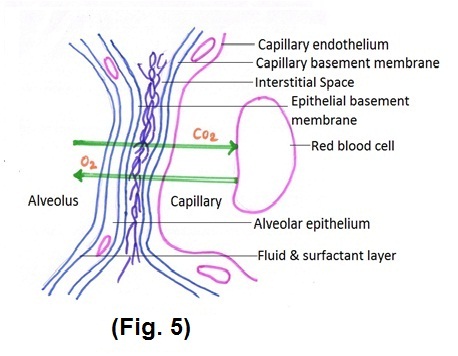
This is a process of diffusion by which uniform distribution of molecules take place. It depends upon no. of factors like
- Thickness of respiratory membrane
- Surface area of respiratory membrane
- Diffusion capacity of gases etc.
The important symptoms which one come across in respiratory diseases are, cough and sneezing. These are physiological responses to get rid of irritant present in the tract.
Coughing — Irritation of larynx, trachea due to irritant, send nerve impulses to the medulla via vagus nerve. A series of events occur, resulting into deep inhalation followed by complete closure of glottis which in turn leads to strong forceful exhalation causing glottis to open and forceful pushing of air through glottis.
Sneezing –– Sneezing starts by irritation of foreign particles present in nasal passages. Nerve impulses via trigeminal nerve pass from nasal mucosa to the medulla. A series of events occur like in cough reflex. However, difference is, in sneezing, uvula is depressed so large amount of air pass rapidly through the nose.
